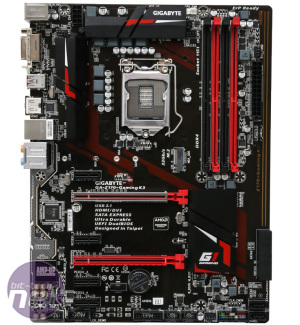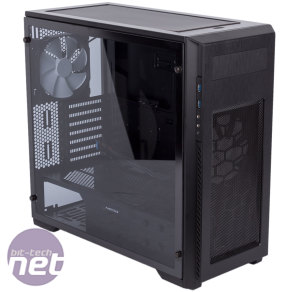
Enthusiast Gamer
The Enthusiast Gamer is all about using cost-effective hardware to net you a system that's suitable for premium 1080p gaming (or even 1440p with a GPU upgrade), has all or most of the latest features and will last for a long time. It's also VR ready, meeting or exceeding the minimum specifications of the HTC Vive and Oculus Rift headsets. It's what we would consider the go-to component choices for most enthusiasts.| Product | UK price (inc VAT) | US price (ex tax) | |
| CPU | Intel Core i5-6600K | £220 | $225 |
| Motherboard | Gigabyte Z170-Gaming K3 | £110 | $160 |
| Memory | 16GB (2 x 8GB) 3,000MHz DDR4 | £100 | $100 |
| Graphics card | Sapphire Radeon RX 480 Nitro+ OC 8GB | £245 | $270 |
| PSU | Corsair CS550M | £75 | $80 |
| CPU cooler | Arctic Liquid Freezer 240 | £80 | $90 |
| Storage (primary) | Crucial MX300 525GB | £115 | $125 |
| Storage (secondary) | 2TB SATA 6Gbps HDD | £65 | $50 |
| Case | Phanteks Enthoo Pro M Tempered Glass | £90 | $90 |
| Total price | £1,100 | $1,190 |
We start with the Core i5-6600K. Featuring four full Skylake cores and an unlocked multiplier, this CPU has all the specifications and power needed to keep games running fast for years to come, and will also serve you well in strenuous CPU-bound workloads like file archiving, photo editing and so on. There's no real reason to opt for the pricier Core i7-6700K unless you do the odd bit of rendering or other highly multi-threaded workloads, as with Hyper-Threading it turns four cores into eight threads. That said, if such workloads take up the bulk of your time, you may want to consider Intel's X99 platform to get even more cores, but beware that it doesn't come cheap.
 16GB of DDR4 is the standard recommendation. There's little reason not to get a 3,000MHz kit as costs are pretty much the same as 2,133MHz kits. Get a pair of 8GB sticks instead of four 4GB ones so you've room for future expansion (though that probably won't be needed for a long time).
16GB of DDR4 is the standard recommendation. There's little reason not to get a 3,000MHz kit as costs are pretty much the same as 2,133MHz kits. Get a pair of 8GB sticks instead of four 4GB ones so you've room for future expansion (though that probably won't be needed for a long time).The Gigabyte Z170-Gaming K3 is an excellent motherboard for the price, with high-end storage and USB standards (although not U.2 or a Type-C connector). It's got great overclocking potential too, as well as CrossFire support in case you want to double up on our recommended graphics card in the future.
That recommended graphics card is the Sapphire Radeon RX 480 Nitro+ OC 8GB. It's an excellent all-rounder, presented in a neat and tidy package, and will smash through games at 1080p with ultra settings and even handle itself well at 1440p.
That said, with the base specifications as they are, the only limiting factor in most games is going to be your GPU, so there are other options here. If you're definitely sticking to 1080p for the foreseeable future, you could opt for the 4GB Sapphire card instead, but if you've an eye on a future CrossFire setup or a 1440p monitor, 8GB is the best bet to stop the frame buffer being a limit. Alternatively, to really dominate at 1440p, the MSI GTX 1070 Gaming X would be our card of choice. There are many other cheaper GTX 1070 SKUs out there, but we can vouch for the excellence of this one. If you do go this route, consider also MSI's Z170A SLI Plus motherboard as an upgrade to the Gigabyte one: It gets you SLI support in case you ever add a second GTX 1070 and also gets you a USB 3.1 Type-C header.
We found the Arctic Liquid Freezer 120 to be an excellent all-in-one water-cooler, with low noise, low temperatures, easy installation and a very fair price. It's a great choice, though we've opted for the 240mm radiator version here, which should be an even better performer for not much more money.
 The Phanteks Pro M Tempered Glass chassis adds a premium twist to an already brilliant chassis design yet stays well under £100. NZXT's S340 Elite is a solid alternative but we've chosen Phanteks for the better upgrade potential and 240mm radiator support.
The Phanteks Pro M Tempered Glass chassis adds a premium twist to an already brilliant chassis design yet stays well under £100. NZXT's S340 Elite is a solid alternative but we've chosen Phanteks for the better upgrade potential and 240mm radiator support.The storage choice prioritises capacity over speed; NVMe SSDs are too expensive for what they offer for this system and have virtually no benefit in games. Our SSD/HDD combination lets you install half a dozen or more modern games comfortably on your boot drive, with many more backed up to the 2TB mass storage hard disk.
A 550W PSU is more than enough to power this system. Our chosen one has a great price, 80 Plus Gold efficiency, low noise output and semi-modular cabling. If you've an eye on a multi-GPU future, we'd push you towards the 750W SilverStone Strider Gold S instead.
Six to nine months ago, this system's hardware cost may have fallen below £1,000, but even as it is we think it offers great bang for buck. Even so, if £1,000 is your strict limit, switching to the 4GB Sapphire card, ditching the HDD, and using the Arctic Liquid Freezer 120 cooler and NZXT S340 chassis will get you there, and you won't be losing much in doing so.

MSI MPG Velox 100R Chassis Review
October 14 2021 | 15:04








Want to comment? Please log in.